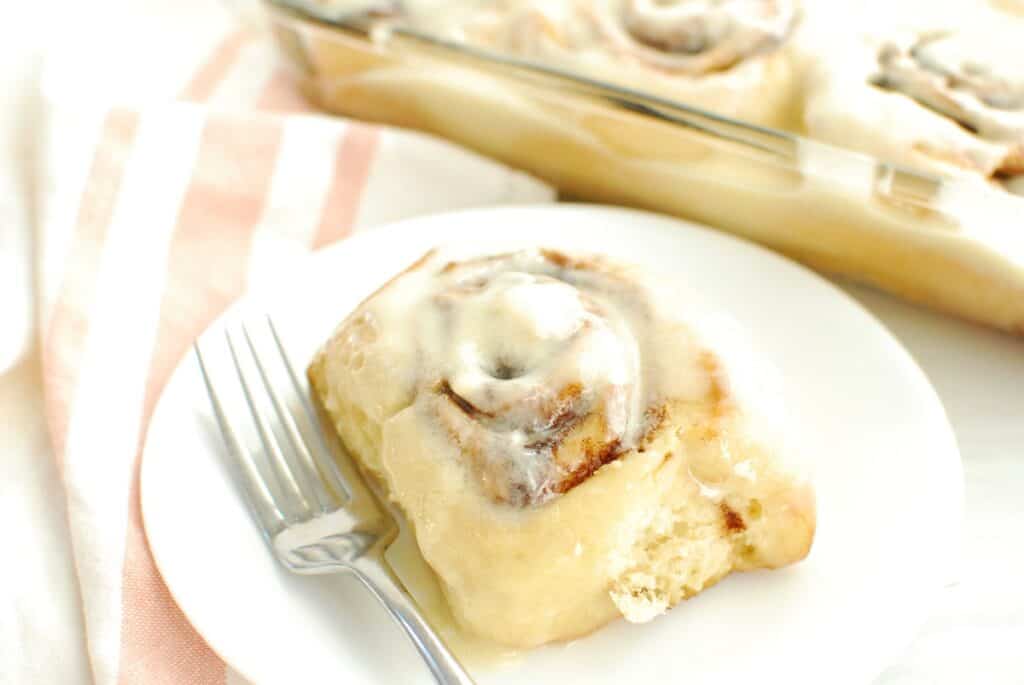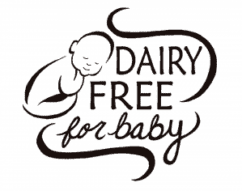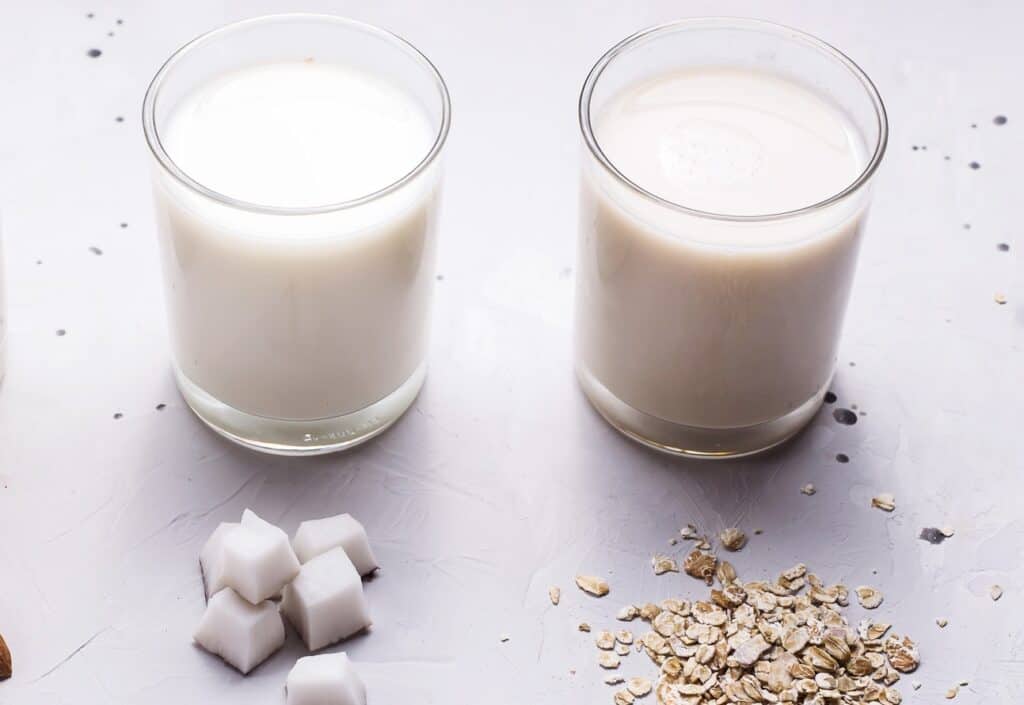These days, there are plenty of dairy-free milk alternatives on the market. When it comes to choosing one, there are many factors that can be considered…nutrition information, ingredients, culinary uses, sensory aspects, price – it can be a super overwhelming choice!
You may be wondering specifically about oat milk versus coconut milk, two options that have become increasingly popular. Here’s a quick guide that may help you make a decision when choosing a milk alternative!
Note: This post was created and written by Kathleen Hickey, a dietetics student at Boston University. It has been reviewed by Chrissy Carroll, MPH, RD.
How are oat milk and coconut milk made?
Each option goes through different processing methods. Let’s take a look at each…
How oat milk is made
Oat milk is created by combining rolled oats with water. Commercially, this is then milled to a fine consistency. Typically, enzymes are added to break down some of the oat starch into sugar (which makes the product taste sweeter). Then, the mixture is strained, and other ingredients (like oils, vitamins, or sweeteners) may be added. (Oatly has a great overview of this process on their site!)
At home, making oat milk is far simpler – you can simply blend rolled oats with water, then strain the mixture to get rid of the pulp.
The main ingredients of oat milk are rolled oats and water, but as you can see, many commercial brands may add additional sweeteners, oils, or other ingredients to create that creamy texture and delicious taste.
The brand Oatly contains:
- Oat base (water, oats), 2% or less of: erucic acid rapeseed oil, dipotassium phosphate, calcium carbonate, tricalcium phosphate, sea salt, dicalcium phosphate, riboflavin, vitamin A, vitamin D2, vitamin B12
How canned coconut milk is made
Coconut milk is made by extracting the milk from the flesh of mature coconuts. There are a couple variations when it comes to what you may purchase from the grocery store.
Canned coconut milk, found with other shelf-stable food items such as canned fruits and vegetables, is the milk directly extracted from the flesh of the coconut (it is not the water found when you crack a coconut open). It is creamy and has a distinct coconut flavor. Canned coconut milk is most suitable for adding fat and flavor when cooking.
The brand Goya canned coconut milk contains:
- Coconut milk, water, potassium metabisulfite (as a preservative)
How coconut milk beverage is made
Coconut milk beverage, found in the dairy aisle, contains that same milk from coconut flesh, but with more fluid (water or coconut water) added. This blend makes it a thinner consistency and more comparable to regular dairy milk. Coconut milk beverage may be more suitable for drinking as a dairy-alternative, or perhaps baking.
The brand Califia coconut milk beverage contains:
- Coconut milk (water, coconut cream), coconut water, calcium carbonate, sunflower lecithin, sea salt, potassium citrate, locust bean gum, gellan gum.
Nutrition differences between oat milk vs. coconut milk
Here is the nutrition breakdown of each product, based on 1 cup of a plain variation. Keep in mind specific nutrition facts may vary based on the product, so take these as general estimates. Always look at the option you’re planning to purchase to see actual nutrition facts, as they can vary based on processing method, flavors, etc.
Oat milk (1 cup plain original)
Source: Chobani Original Oat Milk
- Calories: 110 kcals
- Total fat: 5 g
- Sat fat: 0.5 g
- Carbohydrate: 13 g
- Fiber: <1 g
- Sugar: 7 g
- Protein: 2 g

Canned coconut milk (1 cup unsweetened canned)
Source: USDA FoodData Central
- Calories: 445 kcals
- Total fat: 48 g
- Sat fat: 42.5 g
- Carbohydrates: 6.5 g
- Fiber: 0 g
- Sugar: 6.5 g
- Protein: 4.5 g

Coconut milk beverage (1 cup plain original)
Source: USDA FoodData Central
- Calories: 74 kcals
- Total fat: 5 g
- Sat fat: 5 g
- Carbohydrate: 7 g
- Fiber: 0 g
- Sugar: 6 g
- Protein: 0.5 g

Nutrition Comparison
Canned coconut milk is the most energy-dense and also has the highest amount of total and saturated fat per serving.
Oat milk and refrigerated coconut milk beverage are more comparable dairy-free alternatives. But there are still some key differences between the two.
Oat milk typically contains more calories, protein, and carbohydrate per serving than coconut milk beverage. Because oils are often added to oat milk during processing for a creamy texture, the fat content is often comparable to coconut milk beverage, though coconut milk beverage contains more saturated fat per serving. (However, if you make your own oat milk at home, it would be much lower in fat).
Both of these options generally contain at least 10% daily values of vitamin D and calcium as long as they are enriched. Be sure to check labels as not all products are!
Culinary uses of oat milk vs. coconut milk
There are many ways to utilize these products, whether you are looking to make a recipe dairy-free, or just try a new ingredient. However, it is important to note that it is not always so simple to swap dairy for non-dairy options. Make sure to think about the recipe you may be using, and how the dairy being replaced may impact it!
Oat milk has a more neutral taste than coconut milk, making it more of a 1:1 swap to regular milk. It also has a similar texture, fat, and consistency. This can be ideal for drinking, baking, or use in coffee or smoothies. Oat milk also has the best frothing capabilities, making it great for lattes or cold foam!
Examples of recipes that use oat milk:
- These Dairy-Free Cinnamon Rolls (pictured below) use oat milk and are a great example of how oat milk can be substituted in classic and delicious baking recipes.
- You can also find extra creamy oat milk at the grocery store, which may be more ideal for cooking. The extra thickness can help bring recipes, like this Dairy-Free Clam Chowder, taste like the real stuff!
- Oat milk is also used in our dairy free bread pudding and dairy free yellow cake recipes.

Canned coconut milk has a higher fat content than regular dairy milk or other milk alternatives, so it can be great for adding fat and flavor to dishes. However, keep in mind that it does impart coconut flavor. Chef Abbie Gellman, MS RD CDN, says “If I do not want a coconut flavor then I would not use coconut milk. The dish has to be complemented by a coconut flavor, or it will taste off.”
Examples of recipes that use canned coconut milk:
- This Easy Leftover Turkey Curry (pictured below) is a great use for canned coconut milk, as the coconut curry combo puts a delicious delicious spin on your Thanksgiving leftovers!
- You can also use the fat content in canned coconut milk to make classic desserts such as ice cream or whipped cream dairy-free. This Almond Pear Crisp for Two uses canned coconut milk to make coconut whipped cream for a yummy topping!
- Canned coconut milk can also work well in desserts where the coconut milk adds thickness to a custard or pudding-like filling, such as dairy free pumpkin pie or dairy free chocolate pie.

Coconut milk beverage, on the other hand, can be delicious in coffee, smoothies, or cereal, as it adds a hint of sweetness and subtle coconut flavor.
What about allergies and intolerances?
Coconut milk and coconut milk beverage is made from coconuts. The FDA recognizes coconut as a tree nut, though technically it is a botanical fruit. Some people with other tree nut allergies can consume coconut safely, but some people with tree nut allergies can have severe reactions to coconut. It’s always best avoided until you discuss if it’s safe with your doctor.
Oats are often grown near wheat fields or processed in the same factories with wheat, so some brands of oat milk are unsafe for those with celiac disease or gluten intolerance. If you have these conditions, be sure to look for a brand that is certified gluten free.
What’s on the market? What about pricing?
As dairy-free milk alternatives continue to gain popularity, there are tons of options when you go to the grocery store.
You can find oat milk brands such as Oatly and Planet Oat at most grocery stores. These brands carry regular unsweetened oat milk as well as other options like chocolate oat milk and other flavored oat coffee “creamers,” which may be sweetened or thickened. The average cost of a carton of oat milk is around $3-$6.
Canned coconut milk can also easily be found in the supermarket next to other canned goods. Goya and Thai Kitchen are both brands that sell sweetened and unsweetened coconut milk. Being canned means that they are shelf-stable and last for longer than oat milk or coconut milk beverage, which need to be refrigerated and used within 2-3 weeks of opening. A can of coconut milk will cost around $2-$3.
If you want to pick up coconut milk beverage, Califia Farms and Silk have their own products at the grocery store. These brands carry variations such as unsweetened, toasted coconut, and coconut-almond milk blends. The average cost of a carton or bottle of coconut milk beverage is about $3 to $6.
The bottom line
When making a choice between coconut milk vs. oat milk, it comes down to what you are trying to create. Pay attention to the nutritional content, sensory aspects, and culinary uses of the products, and compare them to the recipe you may be swapping dairy out of, or find a similar recipe if you are creating your own. You can’t go wrong with trying new foods and recipes, and experimenting with new ingredients! The more we cook, the more we learn. 🙂
About the Author
Kathleen Hickey is a dietetics student currently completing her Master’s degree in Nutrition at Boston University. She will start her Dietetic Internship in the Fall of 2023 so that she will be eligible to take the CDR exam in 2024. She also holds a Bachelor’s degree in Dietetics from the University of New Hampshire in Durham.
Kathleen is passionate about nutrition, fitness, and incorporating balance into her life. She loves to go to the gym, try new workout classes, and take her dogs, Jaeger and Madigan out for long walks. Kathleen also believes in the beauty and enjoyment in cooking, eating out, and supporting a healthy relationship with food. She currently resides just north of Boston.

